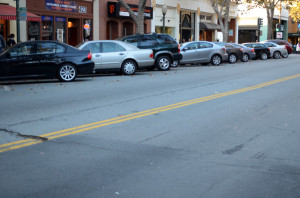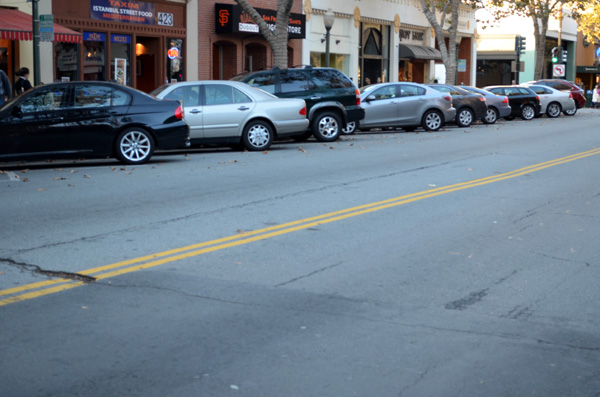Palo Alto officials are looking into radical solutions to the downtown parking shortage, going so far as suspending rules that have allowed monetary fees to substitute off-street parking requireemnts for developers since the mid-1980s.

The Palo Alto City Council imposed a 45-day moratorium in mid-October on a municipal code parking exemption that allowed developers to pay a fee instead of creating off-street parking for the first-floor areas of buildings.
The square footage of upper-floor development is still subject to the standard square-foot-to-parking-place ratio present in the municipal code, which varies depending upon the type of building.
“The moratorium is very limited,” Palo Alto City Council Member Larry Klein said. “It’s just on this one section of our zoning rules….It wouldn’t have any effect one way or another on either future projects or the present parking problem.”
Although Klein said that the moratorium will have no effect on parking in Palo Alto, city staff and consultants will study the parking in the downtown area during these 45 days to determine the best course of action to solve Palo Alto’s parking problems, according to Palo Alto Director of Planning and Community Environment Curtis Williams.
“We have quite a few parking lots around town, and any one of those theoretically could be turned into a parking structure that could accommodate four times as much parking as it has on the one level of the lot right now,” he said.
Williams added that consultants will also conduct a downtown development analysis to see if current regulations could be changed to ensure that new development is not worsening the parking situation.
In the past two years, two developers requested to use the exemption, which Klein said was an unusually high rate. In response, the city council staff studied the exemption to determine if it was appropriate to apply the exemption for these two developers. Klein said that the developers will likely be allowed to go forward with their projects as planned under the exemption, but that the city has yet to determine what the proper parking fund payment is for each developer.
Williams said that the exemption never realized its intended impact on downtown development.
“I don’t think that it really played much of a role in stimulating that development, initially anyway, and certainly it isn’t needed today,” Williams said. “There’s plenty of activity as far as development goes without provisions like that.”
The city zoning code caps downtown development at 350,000 square feet of commercial space, with an automatic stop on development once that cap is reached. The code also requires that the city study the parking exemption if the 350,000-square-foot development were to be reached. However, the code also recommends that the city conduct that study long before the 350,000-square-foot cap, when commercial development approaches 235,000 square feet.
A recent 50,000-square-foot project at 101 Lytton Ave. prompted the city to impose the moratorium because it put the development square footage at about 10,000 under the 235,000-square-foot mark, according to Williams.
Employees of downtown Palo Alto businesses have concerns about parking, especially with regard to the current color zone system, which implements different parking restrictions based on colored signage. The color zone system allows people to park their cars in certain areas of downtown for only two hours at a time without a permit. Visitor permits cost $16 per day, and permits for using the existing parking structures cost over $540 per year.
“There are only purple zones for miles around my business, and it’s impossible to park for more than two hours, especially when I work an 11-hour shift,” said Jeremy Thomas Lay, an assistant manager at SPOT: A Pizza Place. “Every two hours, you can’t re-park in the purple zone, so you have to park a mile away just to go to work. We’ve actually lost a couple of customers because they can’t find places to park around our business.”
However, Williams said that the study is more concerned with long-term permitted parking downtown and what developers will be required to provide than with short-term visitor parking issues.
“Basically, in all counts we’ve done, there seems to always be space [for visitors],” Williams said. “It may not be the most convenient, but there’s always space and [visitors can buy a one-day $15 parking permit].”
Another concern regarding parking in the city is non-residents who park in residential neighborhoods to avoid paying permit fees for downtown zones. According to Klein, residents of Professorville, a Palo Alto district, are lobbying the city council to create a residential parking permit program that would prohibit non-residents from parking in the areas on either side of University Avenue.
